The exhibition is composed of a selection of works of incredible variety, not only in terms of historical time and geography but also in terms of aesthetics and purpose. Some of these works have metaphorical associations, being representations charged with complex symbolism; others, on the other hand, are realistic, being depictions of the human figure as observed by the artist. In this way, the figurations symbolize ideas and concepts common to all societies.
The exhibition is divided into five thematic areas, in no chronological order, with the aim of exploring the human image:
The exhibition is divided into five thematic areas, in no chronological order, with the aim of exploring the human image:
-Introduction
-Ideal beauty
-Portraits
-The divine body
-The body politic
-The transformation of the body
-Ideal beauty
-Portraits
-The divine body
-The body politic
-The transformation of the body
Thus, "The Human Image. Art, identities and symbolism" includes a wide range of cultures, peoples, civilizations, ideas and artistic practices of the past and present. It allows us to approach different ways of expressing and representing identity through art.
The exhibition aims to be engaging, fresh, and accessible, enacting aesthetic enjoyment and inviting reflection, so that the public can draw their own conclusions.
The visual narrative of the exhibition, from a contemporary perspective, includes both Ancient Art pieces and recent works by artists such as Henri Matisse, Goya, Luis de Madrazo, David Hockney, Albrecth Dürer, Édouard Manet, Auguste BoucherDesnoyer, Tom Wesselmann, Antoni Tàpies, Christopher Williams, Vanessa Beercroft, Koya Abe, Frank Auerbach, Anton van Dyck, Craigie Horsfield, Ali Kazim, Esther Ferrer, Farhad Ahrarnia, Juan Navarro Baldeweg, Óscar Muñoz, Rafael Lozano-Hemmer, Craige Horsfield, Ali Cherri, and David Oxtoby, among others.
"The Human Image. Art, identities and symbolism" is accompanied by a cycle of thought entitled Representations of the human coordinated by the Casa dels Clàssics. These lectures and debates aim to invite the spectator to take a journey through the images that humanity has produced of itself throughout history. Delving into the symbolism of power, beauty, illness, and the sacred, in parallel with how the conception of the human being and the world has evolved.





















![Untitled (Study in yellow and red/Berlin) Dirk Schaper Studio, Berlin, 21 June 2007 (no. 2)] Christopher Williams. la Caixa" Collection. Contemporary Art. Image courtesy of Caixa Forum Untitled (Study in yellow and red/Berlin) Dirk Schaper Studio, Berlin, 21 June 2007 (no. 2)] Christopher Williams. la Caixa" Collection. Contemporary Art. Image courtesy of Caixa Forum](/sites/default/files/styles/mopis_news_carousel_item_desktop/public/metalocus_caixa-forum-madrid_la-imagen-humana_21.jpg?itok=UOZmnTB5)



















